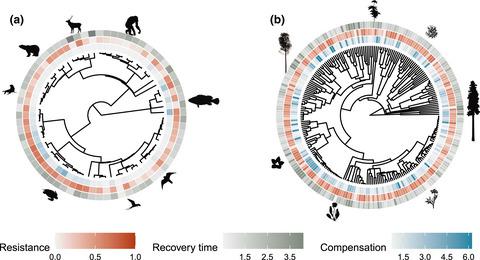当前位置:
X-MOL 学术
›
Ecol. Lett.
›
论文详情
Our official English website, www.x-mol.net, welcomes your feedback! (Note: you will need to create a separate account there.)
Life history mediates the trade-offs among different components of demographic resilience
Ecology Letters ( IF 8.8 ) Pub Date : 2022-03-25 , DOI: 10.1111/ele.14004 Pol Capdevila 1, 2 , Iain Stott 3 , James Cant 4 , Maria Beger 4, 5 , Gwilym Rowlands 1 , Molly Grace 1 , Roberto Salguero-Gómez 1, 5, 6
Ecology Letters ( IF 8.8 ) Pub Date : 2022-03-25 , DOI: 10.1111/ele.14004 Pol Capdevila 1, 2 , Iain Stott 3 , James Cant 4 , Maria Beger 4, 5 , Gwilym Rowlands 1 , Molly Grace 1 , Roberto Salguero-Gómez 1, 5, 6
Affiliation

|
Accelerating rates of biodiversity loss underscore the need to understand how species achieve resilience—the ability to resist and recover from a/biotic disturbances. Yet, the factors determining the resilience of species remain poorly understood, due to disagreements on its definition and the lack of large-scale analyses. Here, we investigate how the life history of 910 natural populations of animals and plants predicts their intrinsic ability to be resilient. We show that demographic resilience can be achieved through different combinations of compensation, resistance and recovery after a disturbance. We demonstrate that these resilience components are highly correlated with life history traits related to the species’ pace of life and reproductive strategy. Species with longer generation times require longer recovery times post-disturbance, whilst those with greater reproductive capacity have greater resistance and compensation. Our findings highlight the key role of life history traits to understand species resilience, improving our ability to predict how natural populations cope with disturbance regimes.
中文翻译:

生活史在人口弹性的不同组成部分之间进行权衡
生物多样性丧失速度的加快凸显了了解物种如何实现复原力的必要性——抵抗和从生物干扰中恢复的能力。然而,由于对其定义的分歧和缺乏大规模分析,决定物种恢复力的因素仍然知之甚少。在这里,我们调查了 910 个自然动植物种群的生活史如何预测它们的内在恢复能力。我们表明,人口弹性可以通过补偿、抵抗和扰乱后恢复的不同组合来实现。我们证明这些复原力成分与与物种的生活节奏和繁殖策略相关的生活史特征高度相关。世代时间较长的物种在受到干扰后需要较长的恢复时间,而生殖能力越大的,抵抗力和补偿力越大。我们的研究结果强调了生活史特征在理解物种复原力、提高我们预测自然种群如何应对干扰状态的能力方面的关键作用。
更新日期:2022-03-25
中文翻译:

生活史在人口弹性的不同组成部分之间进行权衡
生物多样性丧失速度的加快凸显了了解物种如何实现复原力的必要性——抵抗和从生物干扰中恢复的能力。然而,由于对其定义的分歧和缺乏大规模分析,决定物种恢复力的因素仍然知之甚少。在这里,我们调查了 910 个自然动植物种群的生活史如何预测它们的内在恢复能力。我们表明,人口弹性可以通过补偿、抵抗和扰乱后恢复的不同组合来实现。我们证明这些复原力成分与与物种的生活节奏和繁殖策略相关的生活史特征高度相关。世代时间较长的物种在受到干扰后需要较长的恢复时间,而生殖能力越大的,抵抗力和补偿力越大。我们的研究结果强调了生活史特征在理解物种复原力、提高我们预测自然种群如何应对干扰状态的能力方面的关键作用。



























 京公网安备 11010802027423号
京公网安备 11010802027423号